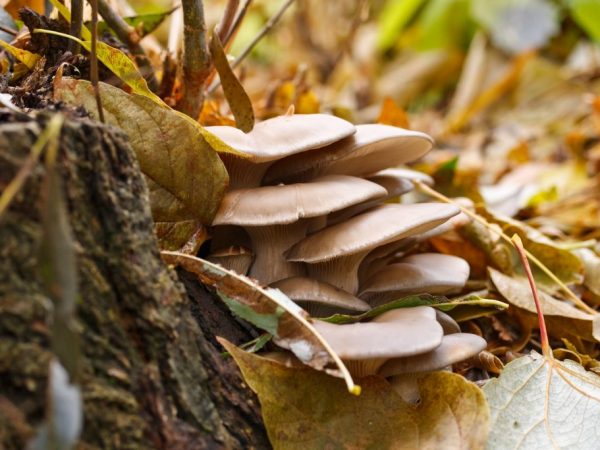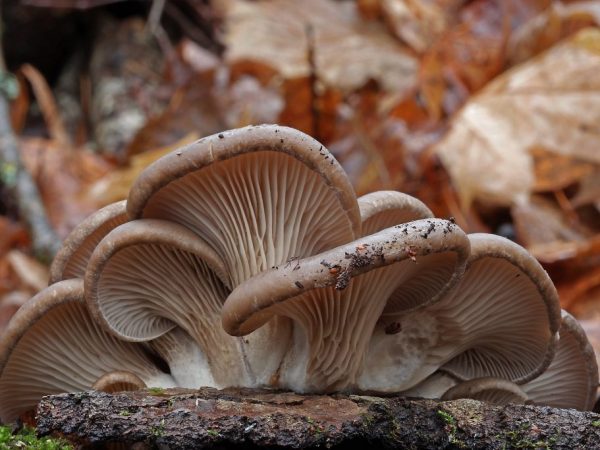Oyster mushroom growth sites
Oyster mushrooms (Oyster mushrooms) - mushrooms growing on dead trees or rotten stumps, they represent a whole genus of Oyster mushrooms, which belongs to the family of the same name Oyster mushrooms. They contain many useful substances: proteins, vitamins B, C, E and D2. Forests are the main growth site for oyster mushrooms, but they are also often grown at home on sawdust or small shavings.

Places of growth of mushrooms Oyster mushrooms
Oyster mushroom in Russia
The range starts from the territories of Primorye and Siberia and extends to the Krasnodar Territory. The middle zone of the Russian Federation is replete with these "predators". Most often, this species is found on the bark of such trees:
- Birch tree;
- aspen;
- oak;
- Linden;
- willow.
But on the trunks of representatives of coniferous trees, oyster mushrooms rarely develop - the presence of resins in the wood affects.
Some species grow on poplars. Although some researchers say that it is not worth picking the fruit bodies growing on this tree, because poplar fluff is a carrier of allergens, it carries pollen from various plants, including those that cause allergies.
Oyster mushrooms grow both in deciduous and mixed forests. It is very rare to see such representatives on conifers. They are found in whole colonies - 20-40 individuals each, high on dry trunks. Sometimes there is a chance to find these mushrooms even in parks or gardens. Oyster mushrooms grow in the forest on dead or diseased trunks, rotten stumps.
The most common in these regions:
- Primorsky Krai;
- Krasnodar region;
- Far East;
- Kuban;
- Caucasus.
Varieties on the territory of the Russian Federation
In total, there are about 30 varieties of this mushroom. Most of them are bred at home. They do not require careful maintenance, but they have excellent taste.
The most famous varieties can be found on the territory of Russia. So, the royal oyster mushroom is easy to spot in the steppe regions. Florida oyster mushroom, native to North America, lives on beech wood in the Caucasus.
Oyster mushroom (Pleurotus ostreatus)
The species is also known as oyster mushroom, or oyster mushroom. These are rather large xylophytic fungi, wood destroyers from the saprotroph group, which are widespread in the forests of the temperate climatic zone. Usually they grow only on dead trees, but there are cases when their colonies were found on living, but weakened plants. They are not picky about the conditions, so they are often grown at home.
In nature, they look like "hanging steps" on the bark. They are classified as edible mushrooms.
The hat has a non-standard shape: 1-2 cm in height, 5-30 cm in diameter (but only in very old specimens). Its surface is usually white, gray or light brown, glossy. The pulp is firm and juicy.
The leg is 1-4 cm in height, smooth to the touch, white or gray. The pulp is fibrous, tough. This is especially noticeable in old mushrooms. Sometimes it is bent to the side, it is practically invisible.It is located off-center, in the side of the cap, in mycology, this arrangement is called eccentric.
Such a mushroom is found in any deciduous forest in Russia, it prefers birches. Fruiting time is the beginning of autumn, because loves relatively low temperatures and good humidity.
Oyster mushroom (Рleurotus pulmonarius)
Sometimes it is also called spring or beech. The most common edible mushroom of this genus under natural conditions.
The hat is round and the edges are slightly downward. Both the flesh and the spores are of a delicate white color.
They grow on beech trees and old birches. Individuals growing on oaks have the best taste. It tolerates transportation and temperature drop well. This species is distinguished by its small size, the diameter of the cap is only 4-8 cm with a pleasant aroma, but its flesh is a little harsh.
Oyster mushroom (Рleurotus cornucopiae)

Mushrooms are common in the Primorsky Territory
Another edible variety. Grows in deciduous forests, a favorite place - the trunks and stumps of elms, birches or maples.
The cap is funnel-shaped with small bulges. Yellow or white, darkens over time. The head is 4-12 cm in diameter.
The leg is white, sometimes absent. The length is up to 1 cm, and the thickness is 1-2 cm. The pulp is always white, dense, with a slightly mealy odor.
This species grows in large groups and sometimes you can smell a spicy smell near them, reminiscent of anise. Due to the formation of large clusters of fruiting bodies, it is also called abundant oyster mushroom.
At negative temperatures, horn-shaped oyster mushrooms grow poorly, although the time for harvesting begins from late spring to autumn (May – October).
Irina Selyutina (Biologist):
Lemon oyster mushroom (Pleurotus citrinopileatus) is found in the wild on the territory of Primorsky Krai, in particular its southern part. For its development, it prefers live or dead elms, or elm dead woods. This selectivity to the substrate gave it the popular name - ilmak. It can also settle on birch trunks. Fruiting lasts from May to October. This species is characterized by a bright yellow color of the cap, which makes it look almost decorative. All or almost all of the crop is formed in the form of one large bunch. When grown at home, it grows well on wheat straw and corn cobs. The intervals between fruiting are 7-10 days.
By the way. Mushrooms of each species, as well as plant varieties, are subdivided into separate lines - strains. For mushrooms, this is the same as breeds for animals or varieties for plants.
Conditions and time of appearance of mushrooms
For the most effective growth, oyster mushrooms need favorable conditions.
For almost all species, the most favorable period is autumn. The stimulus for growth is a decrease in the temperature in the environment. Autumn is the time of rains and constant humidity at a not very high positive temperature. These species grow at this time most productively.
There is no regional pattern for the appearance of this species. This mushroom appears where there are conditions suitable for its development.
Growing oyster mushrooms at home has become popular, because this mushroom is a valuable source of nutrients for the body. To create good conditions it is necessary:
- Preparation of a special substrate.
- Heat treatment to prevent mold.
- Carrying out hydrothermal treatment to saturate the substrate with a sufficient amount of moisture for the normal development of the mycelium.
- Getting a mixture from the substrate and mycelium.
- Placing the mixture in plastic bags.
- Giving bags a flattened shape and perforating their walls.
- Placing bags in a room with high humidity (80-90%) and a temperature not exceeding 25 ° C.
The fruiting period begins 10-14 days after sowing. With proper care during this time, re-harvesting will be in 15-20 days.
Conclusion
Oyster mushroom is an edible type of mushroom that is widespread throughout most of the Russian Federation.Places of productive growth can be in any region during the period of favorable conditions for fruiting. It grows mostly on deciduous trees, rarely on conifers. This mushroom has many useful substances in its composition. It is easily recognized when "hunting", because it has no poisonous counterparts on the territory of Russia.


